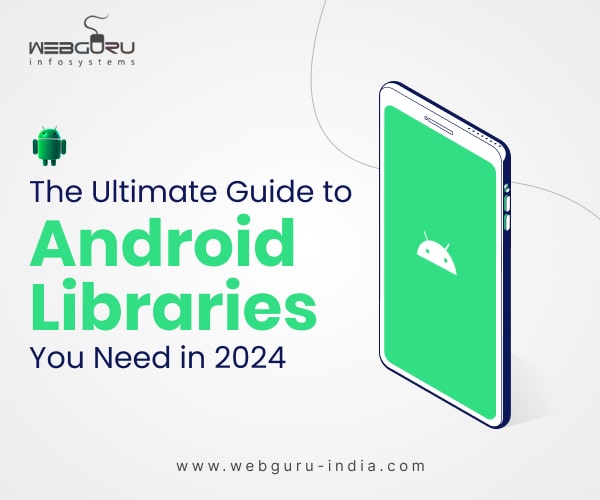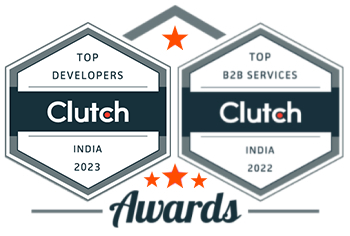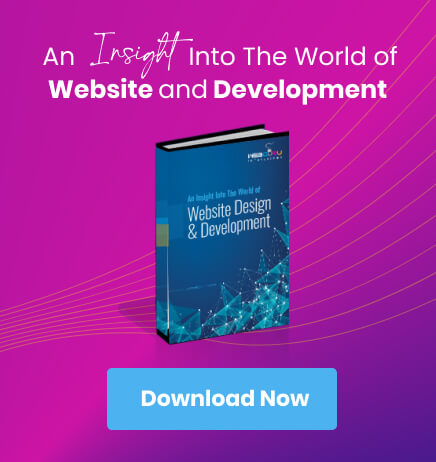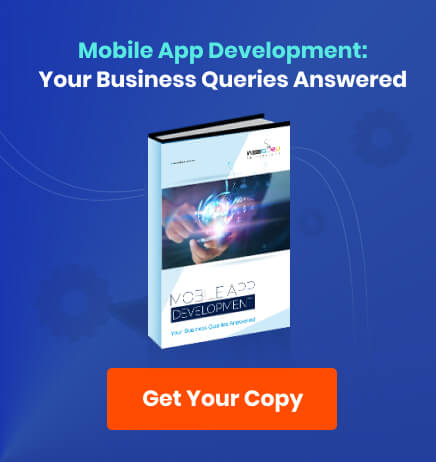Home Blog Mobile App Development Know About the Top Android Libraries In 2024 to Be At the Forefront
Know About the Top Android Libraries In 2024 to Be At the Forefront
- 18 Oct / 2024
- 643 views
- 8 Min Read

Do you want your app to have 5 stars on Google Play Store? For customers to pour love on your application you need to make sure that you take all the right steps while developing it. And, when it comes to developing Android applications that can sustain the overcrowded market, Android libraries have a significant role! Top Android libraries like Picasso, Retrofit, and Android Jetpack will be crucial in 2024 for developers who want to make reliable, aesthetically pleasing, and fast apps. Developers offering the best mobile app development services are using these libraries to create apps that make waves in the market and stand out in the crowd.
The current number of Android applications on the Google Play Store is 1,695,604. Interestingly, the number of applications has received less than 3 ratings is 1,369,536, a whopping 80.8%! This makes it clear that you have to deliver what the customer finds useful. Hence, developing and launching an app just for the sake of it will not help it to sustain in the crowded market! What you need to focus on is building an app using state-of-the-art technologies. And this is where Android libraries come into play!
Developers utilise third-party Android libraries to accelerate the development and designing process, streamline tasks, create a versatile and visually appealing user interface, and ensure compatibility across multiple platforms. Expert developers offering Android app development services possess the expertise to use Android libraries to optimise code and customise the application. In this blog, we have discussed some of the top Android libraries that can help you take the lead in app development and create a futuristic application loved by customers.
So, let’s take a look at the various leading Android libraries for app development.
Android Jetpack
The Android Jetpack library, developed and maintained by Google, is a popular choice among Android developers worldwide. It provides a wide range of resources that ensure consistent and reliable performance for mobile applications, making it the go-to option for developers.
Some key features of Android Jetpack include;
- Simplified code management across different devices, reducing redundancy.
- Prevention of memory leaks caused by faulty components.
- Unaltered Android libraries, ensuring backward compatibility.
- Comprehensive support for essential Android programming languages such as Kotlin and Java, facilitating quick development and deployment.
- Preconfigured libraries and user interface components that follow material design principles and styles.
- Valuable components like ViewModel and LiveData for app projects.
- Concurrent writing and execution of code on both Kotlin and Java runtimes, promoting efficiency.
- Easy integration by adding dependencies to the relevant module.
Picasso
Modern Android applications of great quality depend on an aesthetically pleasing visual design to enhance the UX. This necessitates the utilization of premium images from various image libraries; in this regard, Picasso’s image library that is open source proves exceptionally effective.
We will promptly examine the essential features of Picasso image library;
- It is an user-friendly library allows loading images using remote URLs.
- This library enables Android developers to effortlessly access and integrate server images, as Picasso merely requires creative few codes.
- Picasso demands minimal storage capacity while simultaneously providing auto-storage and caching functionalities.
- Picasso helps detect the reuse of images and can remove old image files instantly.
- Conversely, this library facilitates the conversion of images to various formats while compressing their file sizes.
Retrofit
Retrofit is a highly esteemed library for orchestrating network operations in Android applications. It streamlines API call processes, allowing developers to focus on developing advanced applications without being hindered by networking challenges. Whether it’s a small app or a large corporate solution, Retrofit provides the adaptability and power needed to efficiently handle diverse networking responsibilities.
Some key features of Retrofit include;
- Creation of REST APIs with full type safety, ensuring strong and error-free network calls.
- Support for multiple formats such as JSON, XML, and others, making it adaptable for various backend services.
- Comprehensive error handling to seamlessly handle failures and recover from them.
- Integration with OkHttp to incorporate interceptors for improved performance, security, and logging, including caching and authentication measures.
- Flexibility in supporting both synchronous and asynchronous API calls based on application requirements.
The functionality of Retrofit is crucial for Android app development services that require fast and reliable network operations.
React Native
This library is a Java-Script library that has gained great popularity for developing native mobile applications using advanced web development languages namely javascript, CSS, and React. It is a brain-child of Facebook and is open-source licensed. This groundbreaking library has helped to create cross-platform apps as it gives the developers the scope for sharing the least amount of code possible while maintaining a native user interface and experience. Plus, it also brings down the cost of app development.
Some of the key features of React Native are;
- Utilisation of native components to create applications with an authentic appearance, sensation, and interaction.
- The ability to use the same codebase for web, iOS, and Android applications.
- Easy compilation of React Native code with the code of respective native apps on every OS platform.
- Developers can evaluate code changes while the application is running with the hot reload feature, which does away with the need for frequent reloading.
- Availability of numerous open-source packages to enhance React Native applications with additional features.
Lottie
In today’s world of mobile apps, lively animations can greatly boost user experience and give an app a unique edge over others. However, it is not always easy to put these animations into effect; this process may require lots of resources and be complex without appropriate tools. Lottie, a library made by Airbnb, tackles the problem by making it simple for developers to include intricate animations crafted in Adobe After Effects within their Android apps. The utilization of JSON files to naturally render these animations in Lottie overcomes the separation between design and development by allowing for better user interfaces that are interactive.
- Lottie allows developers to deliver rich, high-quality animations without compromising performance.
- The library is handy to join with Android projects, needing very little arrangement.
Developers can customize animations and modify them at runtime, which provides more design flexibility. - Lottie animations are light and optimized, meaning they won’t make your app work slower
- Lottie can render animations on different platforms, such as mobile and web, to make sure users have a similar experience.
- Lottie is an open-source library that has a huge community. You can find many documents and resources to help you, so it’s not hard to search for answers or ideas.
- Lottie is used by developers who offer top-notch mobile app development services as it boosts the visual attractiveness of apps making lively and captivating user interactions possible.
Dagger2
Dagger2, which is the recent version of the Dagger library, has been a popular choice among Android app developers for many years. It maintains its position as a leading library in handling dependency injections in Android development while offering powerful injection capabilities for projects related to mobile application creation on this platform. The latest version of the well-known Dagger library, called Dagger2, has become a mainstay for those creating Android apps over time. It remains at the forefront in managing dependency injections when compared with other libraries dealing with it on this platform.
Some of the key features and capabilities of Dagger2 are the following:
- This DI library enables a single model to accept and merge several parts from varied models
- It can handle very complicated requirements for large apps needing multiple dependency injections.
- It is not just about Dagger2’s ability to create strong dependency graphs; it also provides developers with amazing controls and adaptability.
Glide
On Android, Glide is an advanced library that handles image loading and caching in a very efficient and flexible manner.
- Glide is very good at loading and showing images quickly. It does this even when there are complex situations with big or many images.
- It automatically deals with memory management according to the device’s resources, decreasing the possibility of OutOfMemoryErrors.
- Developers can use Glide to apply custom transformations like cropping, resizing and making corners round directly in the library.
- This library has strong disk caching capabilities, decreasing the requirement to reload images from the network and enhancing performance.
- Glide is compatible with RecyclerView, which makes sure that scrolling remains smooth and performance stays at its best for user interfaces based on lists.
This library is very important for mobile app development services. In these services, there is a lot of focus on media-rich content and having a consistent way to handle images is crucial.
Also, read our blog on mobile app development trends to look for in 2024.
Conclusion
Updated knowledge of Android libraries is important for developing advanced apps. To help you stay ahead of the curve, this blog has discussed the various Android libraries that would be of great help. When you collaborate with a top service provider offering mobile app development services, you can stay assured that they are using the best resources as libraries to develop advanced applications.

Sayari Banerjee
Dedicated SEO content writer, having a penchant for knowledge, and an insatiable appetite for reading books.
1 comment
Leave a Reply

-
1000+
Happy
Clients -
25+
Countries
Served -
19+
Years of
Trust








This is a great post about Android libraries! It’s really helpful to see how they can be used to build better apps. Thanks for the great post!